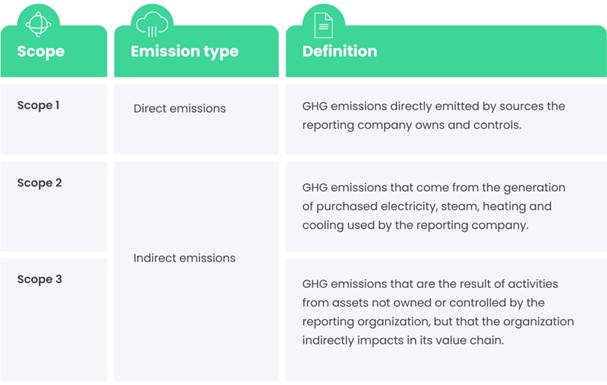
Written by Dipak
Jul 27, 2023 | 5 Min Read
Decoding Corporate Emissions: Exploring Scope 1, 2, and 3 and their Impact on Sustainability
With the global pursuit for sustainability and an increasing need to address global warming, the significance of corporate emissions cannot be over-emphasized. The intricacies surrounding emissions under Scope 1, Scope 2, and Scope 3 emissions categories have come to the forefront and are shaping the approach to sustainable practices. In order to achieve net zero and carbon neutrality, it is important to understand these emissions and how controlling them can benefit us all.
In this article, we will break down these terms into their simplest forms and offer an expansive exploration of their profound relevance and the far-reaching consequences they bear on the well-being of our planet.
Introduction to the Concept of Corporate Emissions and Their Significance in Sustainability Efforts
Corporate emissions are emissions generated by an organization/corporation’s facility. This includes emissions from the corporation’s factories, vehicles, and power plants, as well as those generated by third parties who supply the corporation’s energy. These emissions are categorized into, Scope 1, Scope 2 and Scope 3. Let’s take a look at them.
 Source: Cicrularise
Source: Cicrularise
Scope 1: These are also known as Direct Emissions, and include all emissions produced by the companies’ owned operations, things like the company building, and company-owned vehicles. These emissions are the result of actions that the company directly controls. For instance, if a manufacturing facility uses fossil fuels like coal or gas to power its machinery, the emissions produced from burning those fuels on-site would be considered direct emissions. Another example could be the emissions released from a company-owned fleet of vehicles used for deliveries or transportation.
Scope 2: These are also known as Indirect Emissions and involve a wider scope of emission and go beyond the boundaries of direct operations to encompass the indirect emissions associated with the energy generation of the company. Indirect emissions come from sources that are not directly owned or controlled by the company but are connected to its activities. A prime example of indirect emissions is the energy used by a company, which often comes from external sources like power plants. Let’s say a company relies on electricity to operate its offices, and this electricity is generated from coal or natural gas at a power plant. The emissions generated during the production of that electricity are considered indirect emissions for the company using it. Another example could be emissions related to the production of materials used in a company’s products, like the emissions produced while mining raw materials for a smartphone.
Scope 3: These are equally referred to as Indirect Emissions, and they encompass the entire value chain of a corporation. That is all activities both in and outside the company that have a connection with the company. Beginning from the suppliers at the top to the customers at the bottom.

Source: Net0
How Organizations Can Mitigate Emissions in Each Scope
Mitigating Scope 1 Emissions
Innovative companies can take bold steps to slash their Scope 1 emissions by implementing comprehensive strategies. These strategies include initiatives, such as transitioning from the use of regular vehicles to electric vehicles (EVs), adopting renewable energy sources for on-site operations, and embracing cleaner and more sustainable industrial processes. For instance, an automobile manufacturing company can invest in the use of electric delivery trucks for its logistics, reducing emissions from combustion engines. Another example could be a factory shifting from fossil fuels to solar energy to power its machinery, cutting down on direct emissions associated with traditional energy sources.
Mitigating Scope 2 Emissions
Companies can make significant strides to mitigate their Scope 2 emissions by strategically addressing their energy consumption. One approach involves procuring renewable energy directly, such as installing solar panels on company buildings or purchasing renewable energy credits. By doing so, they are not only decreasing their reliance on fossil-fuel-generated electricity but also fostering a cleaner energy mix. Take a technology company as an example; they can partner with wind farms to ensure a portion of their electricity comes from renewable sources, effectively reducing their indirect emissions tied to energy consumption.
Mitigating Scope 3 Emissions
Again, companies can forge collaborative efforts with their supply chain partners to manage their Scope 3 emissions. These efforts include optimizing logistics and transportation to minimize emissions generated during the transportation of goods. Additionally, they can embrace circular economy principles, where materials are recycled and reused, reducing the overall environmental impact. Take for instance a fashion brand collaborating with suppliers to minimize transportation distances and employing recycled materials for their products, thereby reducing both transportation-related and product lifecycle emissions.
How Organizations Can Measure Scope 1, 2, and 3 Emissions
One of the most effective ways for organizations to measure their emissions is by leveraging cutting-edge technologies. Depending on your location and your industry, there are software dedicated to helping you accurately measure emissions. Most of this software has a simple working principle where you upload your company data and it pinpoints where most emissions occur in your value chain and you can go on to make necessary changes. Organizations can get their Scope 3 data from varying sources, but for the Scope 1 and 2 data, it can easily be gotten by calculating the Greenhouse gas (GHG) emissions against purchased fuel and electricity.
Benefits of Reducing Emissions
Mitigation of Climate Change
As we increase our efforts to mitigate emissions, we are indirectly combating climate change which is a far more dangerous phenomenon. The reduction of these greenhouse gas emissions contributes to mitigating extreme climatic events that threaten the existence of life on Earth.
Enhanced Air Quality and Public Health
A reduction in emissions begets cleaner air, there will be fewer traces of the likes of nitrogen oxides and sulfur dioxide which are harmful to humans when introduced into the bloodstream. By doing this, we can increase the life expectancy of living things on Earth. Cleaner air cultivates an environment where quality of life thrives, ensuring that communities breathe easy and prosper.
Conclusion
In conclusion, in order to understand the impact of corporate emissions on the planet and how we can mitigate them, we must first understand, Scope 1, Scope 2, and Scope 3 emissions. It is important that we adopt emission reduction strategies, both at an individual level and at the organizational level. This is the first step towards ensuring the safety of our planet.
 Blog Posts
Blog Posts
Mar 21, 2023 • 3 Min Read
Sep 25, 2023 • 4 Min Read
Dec 15, 2023 • 3 Min Read